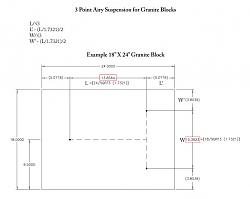
Originally Posted by
mklotz

Let me describe it another way. Imagine a stick whose length is the length of the surface plate divided by the square root of three. Lay this on the plate such that there is an equal gap between the end of the stick and the edge of the plate at each end of the stick. Mark lines across the short dimension of the plate at each end of this imaginary stick. These lines define the Airy lines for the plate. If you supported the plate with bars laid along these lines, it would have the minimum deflection at the midpoint.
The arithmetic in my post shows that those lines would lie a distance from the edges that is 21% of the length of the plate.
A three point Airy suspension would put two points on one of these lines, spaced equal distances from the long edge of the plate and a third point in the middle of the other line.
I wouldn't use a conical point. An elephant foot to spread the load so the granite isn't damaged makes more sense.
My feeling is that, for the typical Enco/Grizzly plate, worrying about suspension points is mostly nonsense. These small plates aren't that flat and, being short, they are stiff so bending isn't really an issue for any work done in the typical hobbyist venue. Leveling the plate isn't really an issue either unless you intend to use a level to do some of your layout; I don't so for me the major concern is flatness and that's more a production concern than a support concern.


 LinkBack URL
LinkBack URL About LinkBacks
About LinkBacks


 Reply With Quote
Reply With Quote






Bookmarks